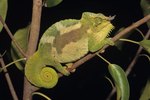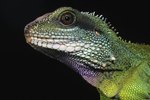
Commonly -- though incorrectly -- called “chameleons,” anoles are small to medium lizards that are capable of stark, and often rapid, color changes. While scientists understand how anoles change color, they do not completely understand why they change color. Beautifully camouflaged at times, these diurnal animals communicate through visual methods, and many anoles have evolved colorful dewlaps to deliver territorial or breeding messages.
Colonizing the Caribbean
Almost 400 species of anoles inhabit Central America, South America and the southeastern United States; however, the group achieves its greatest diversity on the islands of the Caribbean Sea. Most anoles share a suite of similar characteristics, including largely insectivorous diets, diurnal activity patterns and the reliance on visual communication. While broadly similar, the various species are diverse in terms of color, preferred perching locations and size.
Carefully Cryptic
Hunted by many birds, anoles rely on camouflage to evade detection. Species that inhabit the canopy and upper trunks of trees, such as green anoles (Anolis carolinensis), are often green, while the species that live on the ground or at the base of trees, such as Bahaman anoles (Anolis sagrei), are often brown. Many anoles have cross markings along their back, which helps to disrupt their outline.
Color Changing Capabilities
Anoles change their skin color using cells called chromatophores, which lie in separate layers beneath the anoles’ outer skin. The outer layer contains yellow-colored xanthophores, under which lies a layer of reflective iridophores. The melanophores, which carry black pigment, are the deepest layer. It is the melanophores which are responsible for the color change in anoles. When the melanin pigment is concentrated in one location within each cell, the lizards look green; but when the melanophore-stimulating hormone -- which is released by the pituitary gland -- triggers the dispersal of melanin within the cells, the lizards turn brown.
Color Changing Causes
Scientists have yet to discern the exact cause of color change in anoles; most studies have refuted rather than supported the hypotheses of researchers. Contrary to the idea that anoles change their colors to camouflage with their surroundings, a 1995 study by Thomas A. Jenssen of Virginia Tech and his colleagues from the Savannah River Ecology Laboratory and the University of Tennessee found that anoles matched the color of their surroundings less often than predicted by chance. While some workers have suggested that anoles use their color changing ability to thermoregulate, Shinji Yabuta and Akiko Suzuki-Watanabe found that anoles did not exhibit behavior consistent with the thermoregulation hypothesis either. Yabuta and Suzuki-Watanabe did collect some data suggesting that anoles may use their color changing abilities in social contexts, and reported their findings in a 2011 issue of “Current Herpetology.”
Captivating Casanovas
When anoles want to defend a territory or entice a mate, they climb up conspicuous perches and engage in species-specific sequences of head bobs and “pushups.” During the displays, anoles move their retractable dewlaps in and out. The color of these dewlaps varies by species, but is usually bright yellow, orange or red. The males of all species possess dewlaps, but some females have rudimentary dewlaps and others lack these structures entirely. Some species may extend their dewlaps when attacked by predators, in order to make them appear larger.
References
- Animal Diversity Web: Polychrotidae
- Reptile Database: Anolis
- Current Herpetology: Function of Body Coloration in Green Anoles (Anolis Carolinensis) at the Beginning of the Breeding Season: Advertisement Signaling and Thermoregulation
- Anole Annals: New Study on Color Change In Green Anoles
- Herpetological Monographs: Behavioral Profile of Free Ranging Male Lizards, Anolis Carolinensis, Across Breeding and Post-Breeding Seasons
- Cell and Tissue Research: Chromatophores and Color Change in the Lizard, Anolis Carolinensis
Photo Credits
-
Thinkstock Images/Stockbyte/Getty Images




